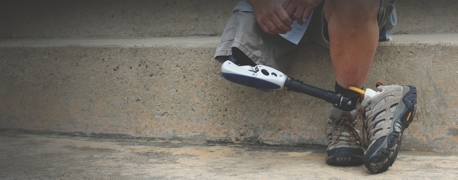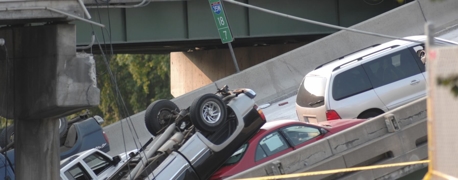What Parents Need to Know About Garage Door Hazards

From guarding the cleaning supplies to putting a fence around the swimming pool, there are well-known hazards that you protect your kids from around the home. The garage door, on the other hand, can fly under the radar as a safety risk, even as it’s used several times throughout each day without a second thought. When a garage door malfunctions, however, this can cause serious injuries or even death, especially if the malfunction causes an entrapment or crushing accident. Just as you have your kids stay away from the stove or out of the street, the garage door needs to be viewed and treated with care.
The Safety Data on Garage Doors
According to the U.S. Consumer Product Safety Commission (CPSC), around 60 to 73 children were killed by automatic garage doors leading up to March 1982, which was before new regulations were put in place. These were kids aged 2 to 14 years old who were trapped by the garage door when it failed to stop and reverse automatically when someone was in its path. Similar accidents have led to countless traumatic brain injuries and other catastrophic trauma as well.
According to the U.S. Consumer Product Safety Commission (CPSC) and similar data from the National Electronic Injury Surveillance System (NEISS) on garage door accidents, there are, on average:
- Approximately 2,000 crushing injuries;
- Four crushing deaths;
- 7,500 pinching injuries (often fingers getting caught); and
- Between 20,000 and 30,000 total injuries each year.
The Hazards Presented by Garage Doors
Any household with a garage door is likely to use it at least twice every day. If anything goes wrong, that means that more than 100 pounds of heavy door could fall onto someone. With larger garage door models, the weight involved could reach more than 200 pounds.
Some of the causes of garage door accidents can include the failure of:
- Automatic sensors
- Garage door springs
- Garage door panels and hinges
- Windows
If automatic sensors haven’t been installed or no longer work, then a closing or falling garage door can quickly cause harm to someone in its path. That someone is all too often a small child who was darting underneath the defective garage door.
Even if the sensors are working, if the garage door springs fail (if they get rusty, go slack, or crack), the garage door can suddenly slam down. This can also happen if the doors fall off the track. Finger-pinching injuries can occur at various pinch points.
Especially in the case of older garage doors, glass windows may not be shatter-resistant or shatterproof, and whether it’s the impact of something striking the door or a result of a door slamming down, there are hundreds of emergency room trips each year to deal with lacerations and cuts caused by glass shattering.
Finally, Some Garage Door Regulations
Even though children were being killed by preventable garage door malfunctions every year, it took decades of these tragedies occurring before steps were taken to force garage door companies to do something about these accidents.
It wasn’t until 1991 that imported or American-made garage doors were required to have a reversing system, and it wasn’t until 1993 that external entrapment protection was also mandated.
The external entrapment provision would be satisfied by things such as:
- Electric eye sensors
- Door edge sensors
- Any similar device that is 4 to 6 inches off the ground
These sensors are meant to ensure that garage doors won’t close on and crush anything or anyone by stopping the door in its tracks and automatically reversing. However, these regulations did not mandate the retrofitting of garage doors that were already made and installed. Because of how long it took to even have these regulations in place, there could easily be millions of homes across the country that have outdated and thus hazardous garage doors.
How You Can Test If a Garage Door Is Up to Code
It is up to garage door manufacturers and installers to ensure that a door functions well, but risks from garage doors persist, nonetheless. Even though it’s ultimately not your responsibility, there are things you can do to ensure that your garage door is safe. The following are some tests you can perform on your garage door, ideally once a month.
Testing That the Garage Door Stops & Reverses
First, you might need to adjust your door’s force settings if it doesn’t stop and reverse when you push the door up with a mild amount of force.
To test the garage door’s safety if someone ends up in its path, it’s often suggested that you place a 2-by-4 plank of wood below the door. Then you can see if the door will stop and reverse once it touches that plank.
However, that’s not always a good gauge of how much pressure the heavy garage door is applying before it reverses. It would be better yet to test the garage door with a paper towel roll. That way, if the door does stop and automatically reverse when it meets the roll, but the roll is still crumpled, you would know that the door could still cause injuries and needs to be serviced.
Why do some experts recommend using a paper towel roll instead of a wood plank? In one study conducted on the risks of automatic garage door openers and accidents that harm children, researchers found that cases where a wood plank was used in tests, a garage door would stop and reverse 88% of the time. However, with those same garage doors, when a child-sized CPR dummy was used for the test, the garage door would only stop and reverse in 60% of cases.
That means that in nearly 30% of cases where a garage door would pass the wood plank test, it would still pose a danger to children who happened to be in the door’s path. That left another 12% of tests where the garage door simply wouldn’t stop or reverse at all.
If the garage door stops and reverses its trajectory when it comes into contact with a paper towel roll that sits below the sensors, well and good. If, however, the door doesn’t stop, or if it crumples the roll before reversing, then you’ll want to disengage the door opener until the door can be serviced. Until then, it’s recommended that you only open and close your garage door manually.
Testing That the Garage Door Is Balanced
The CPSC recommends testing the garage door and opener once a month, not only with the paper towel roll, but also making sure it can stay in place if you stop the door when it’s only opened partway. If the door can’t stop exactly at random positions or keeps moving for a while after you push the button, then you will need the door and/or opener to be inspected and repaired. Again, you’ll only want to open and close the door manually until it’s safe to use the remote opener again.
Manual Test for the Garage Door
It’s important to test the garage door without the remote as well. If you haven’t tested the red cord hanging from the garage door motor before, it’s also important to make sure you’re familiar with how to use it.
This would mean tugging on that quick-release cord to disconnect the door from the remote opener and manually moving the garage door up and down to inspect how well the springs, hardware, and fittings are working. When you move the door manually, it should slide along the tracks smoothly without you having to exert yourself; this is how you would need to be able to lift the door if it ever does entrap someone. You should also be able to roll the door down to 3 or 4 feet above the ground, let go of the door, and have the door stay in place without budging.
If the door fails at any of these points, then it poses an entrapment risk. All you may need to do is clean and oil the garage door tracks or check the manufacturer’s recommendations for similar maintenance steps. Otherwise, you may need to seek a professional inspection and repair.
Steps You Can Take to Keep Kids Safe Around Garage Doors
In addition to testing your garage door, the following tips can help protect your kids:
- Safety awareness and instructions
- Safe placement of the button or keypad on the wall
- Redundant sensors and warning signals
- Restricted access to mobile/remote door openers
It is important to teach your kids that they should never run under the garage door when it’s opening or closing, and that playing with the garage door is wildly dangerous. That is something you can model with your behavior, by not being in the habit of ducking under a garage door as it rolls shut or open. It’s safer not to normalize crossing the path of a moving garage door, nor to be comfortable standing in the doorframe.
Even if you know that your garage door is currently up to code, sensors may malfunction. There are also many other homes where the garage doors were made and installed before 1993, or that have never been tested since. Whether it’s at a grandparent’s house, the next-door neighbor's, or somewhere else, educate your child that no garage door is safe to stand underneath or to try to race.
While awareness and instruction are important, they are not reliable on their own.
That is why the CPSC recommends that the door opener button or keypad be installed at a point along the wall that is still within comfortable reach for you, but that is still high enough to be out of a child’s reach. They also advise parents to keep remote door openers away from kids.
The garage door industry and CPSC also refer to UL Standards & Engagement for expert recommendations, which include redundant sensors. For example, you could install both eye sensors and edge sensors. If one fails, there is a backup system already in place.
As mobile phone apps can now open and close garage doors, which enables somebody to move the door without having to personally monitor the door, the UL recommendation is to equip garage doors with audiovisual alerts. For example, you could install a light that flashes and a buzzer that goes off whenever the garage door is closing, so that nobody is surprised by the door’s movement.
Accountability for Garage Door Accidents
When the unthinkable happens and a child is harmed in a garage door accident, by law it is another party—and not the child—who is responsible. Whether it is a landlord, property manager, or neighbor who failed to keep the premises safe, or a garage door manufacturer or installer who failed to abide by safety codes, it can take legal action to ensure that everyone is doing their part. You’re doing all you can to keep your kids safe, and you and your family deserve to feel and be safe in your own home, as well as in the homes of family and friends.
- Categories


